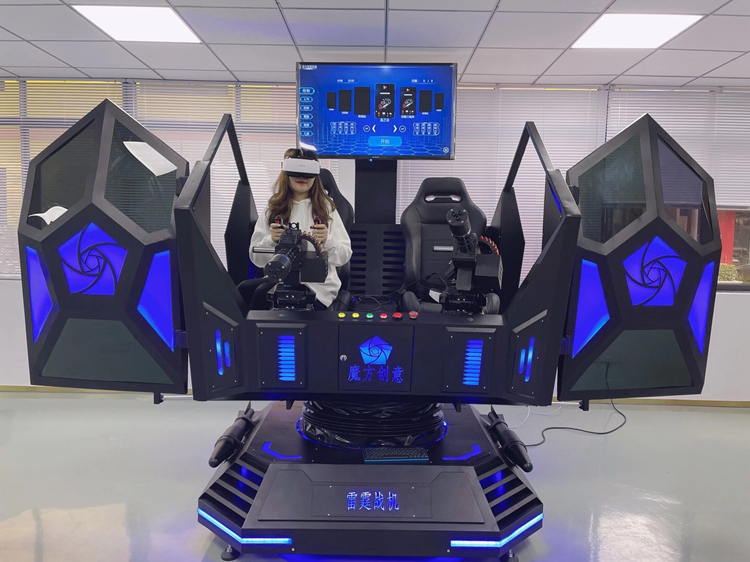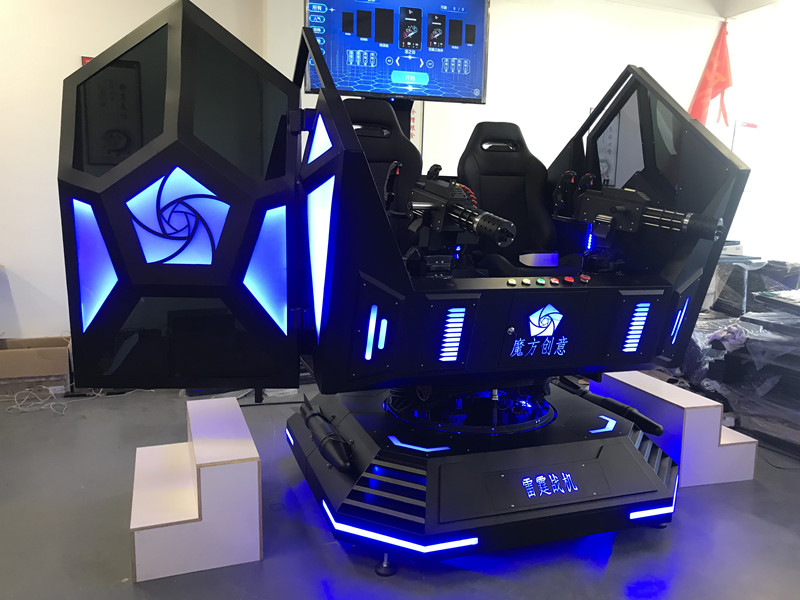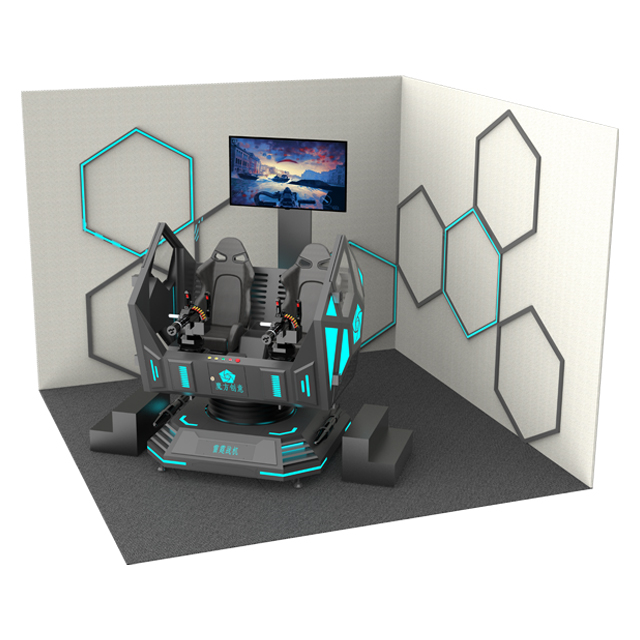Virtual Reality (VR) shooting games represent an immersive and exhilarating frontier in gaming. As players don VR headsets and enter digital realms, they’re transported to action-packed environments where every movement feels real and every decision matters. These games blend cutting-edge technology with the adrenaline rush of traditional shooters, offering an unparalleled gaming experience.
InVR shooting games, players wield controllers as virtual weapons, aiming, shooting, and strategizing as if they were on the battlefield themselves. The sense of presence is heightened, with players physically ducking, dodging, and taking cover to survive intense firefights. This level of immersion creates a visceral thrill that traditional gaming simply can’t replicate.

Moreover, VR shooting games offer a new level of interactivity and realism. From realistic gun mechanics to lifelike environments, every detail is designed to pull players deeper into the game world. Multiplayer modes allow friends to team up or face off in virtual combat, enhancing the social aspect of gaming.
لكن, VR shooting games also present unique challenges. Motion sickness can be a concern for some players, especially in fast-paced games with rapid movement. Additionally, the cost of VR equipment may be prohibitive for some gamers, limiting access to this cutting-edge experience.
Despite these challenges, VR shooting games continue to push the boundaries of gaming, offering an unparalleled level of immersion and excitement. As technology advances and VR becomes more mainstream, the future of virtual shooting games looks brighter than ever.
Evolution of VR Technology in Gaming
The evolution of VR technology in gaming has been nothing short of revolutionary, transforming the way players interact with virtual worlds and redefining the gaming experience. From humble beginnings to the cutting-edge technology of today, VR has undergone significant advancements in both hardware and software, paving the way for immersive and lifelike gaming experiences.
Early VR gaming experiences were limited by technological constraints, with bulky headsets, low-resolution displays, and limited tracking capabilities. Despite these limitations, early pioneers laid the groundwork for future innovation, demonstrating the potential of VR to transport players to new worlds and experiences.
Over time, advancements in hardware have propelled VR gaming forward. Lightweight and ergonomic headsets with high-resolution displays now offer stunning visuals and immersive environments. Inside-out tracking systems, powered by advanced sensors and cameras, enable precise movement tracking without the need for external sensors or cables, enhancing immersion and freedom of movement.

The evolution of VR controllers has also played a crucial role in enhancing the gaming experience. Modern controllers feature ergonomic designs, intuitive button layouts, and precise motion tracking, allowing players to interact with virtual worlds naturally and intuitively. Haptic feedback technology further enhances immersion by providing tactile feedback in response to in-game actions.
On the software side, developers have leveraged advancements in graphics technology to create stunningly realistic environments and lifelike characters. From action-packed shooters to immersive storytelling experiences, the variety of VR games continues to expand, catering to a wide range of preferences and interests.
Moreover, the integration of social features and multiplayer functionality has transformed VR gaming into a truly social experience. Players can team up with friends, compete against rivals, or explore virtual worlds together, fostering a sense of community and camaraderie.
Looking ahead, the future of VR gaming is filled with promise. Continued advancements in hardware and software are expected to further enhance immersion, realism, and interactivity. As VR technology becomes more accessible and mainstream, the possibilities for immersive gaming experiences are endless, promising an exciting future for gamers everywhere.
Immersive Gameplay Experience
The immersive gameplay experience is the holy grail of gaming, where players are fully absorbed and engaged in the virtual world to the point where they forget about the outside reality. Achieving immersion involves a combination of factors that stimulate the senses, evoke emotions, and encourage deep engagement.

One of the key elements of immersive gameplay is realistic graphics and audio. High-quality visuals and lifelike sound effects create a believable virtual environment that draws players in and makes them feel like they’re truly part of the game world. This includes detailed environments, realistic character animations, and dynamic audio that reacts to in-game events.
Interactivity is another crucial aspect of immersion. Players should feel like they have agency within the game world, with their actions having meaningful consequences. This can include responsive controls, complex game mechanics, and branching narratives that allow players to shape the outcome of the game through their choices.
Seamless integration of gameplay mechanics is essential for maintaining immersion. Any disruptions or inconsistencies in the game mechanics can break the player’s immersion and remind them that they’re just playing a game. This includes things like intuitive user interfaces, smooth transitions between gameplay and cutscenes, and consistent rules and physics within the game world.
Storytelling also plays a significant role in creating immersion. A compelling narrative with well-developed characters and engaging plot twists can draw players into the game world and keep them invested in the outcome. This involves creating believable characters, meaningful dialogue, and memorable moments that resonate with the player long after they’ve finished playing.
Finally, immersion is enhanced by the player’s imagination and suspension of disbelief. When players are emotionally invested in the game world and willing to overlook its flaws and limitations, they’re more likely to become fully immersed in the experience.
Overall, achieving immersive gameplay requires careful attention to detail and a deep understanding of what captivates and engages players. By creating believable worlds, meaningful interactions, and compelling narratives, game developers can transport players to new and exciting realities where the boundaries between the virtual and the real begin to blur.
Popular VR Shooting Game Titles
Several popular VR shooting games have captivated players with their immersive gameplay and adrenaline-pumping action. Here are some notable titles:
1. Half-Life: Alyx: Developed by Valve Corporation, “Half-Life: Alyx” is a critically acclaimed VR first-person shooter set in the iconic “Half-Life” universe. Players step into the role of Alyx Vance as they navigate through a dystopian cityscape, battling alien creatures and solving puzzles using innovative VR mechanics.
2. Beat Saber: While not a traditional shooting game, “Beat Saber” is a wildly popular VR rhythm game where players use lightsabers to slice through blocks in time with the music. With its addictive gameplay and energetic soundtrack, “Beat Saber” has become a staple of VR gaming.
3. Arizona Sunshine: In “Arizona Sunshine,” players must survive a zombie apocalypse in the sweltering heat of the Arizona desert. Armed with an arsenal of weapons, players embark on a quest for survival, battling hordes of undead enemies in both single-player and multiplayer modes.

4. Pavlov VR: Inspired by classic first-person shooters like “Counter-Strike,” “Pavlov VR” is a fast-paced multiplayer shooter with realistic gun mechanics and intense gunfights. Players can team up with friends or compete against each other in a variety of game modes, including team deathmatch and search and destroy.
5. Onward: “Onward” is a tactical multiplayer shooter that emphasizes teamwork and realistic military simulation. Players must work together to complete objectives and outsmart their opponents in intense firefights across a variety of maps and scenarios.
6. Superhot VR: “Superhot VR” is a unique first-person shooter where time only moves when the player moves. Players must strategically plan their actions and dodge incoming bullets as they take down enemies in a stylish and cinematic fashion.
These are just a few examples of the many VR shooting games available, each offering its own unique gameplay experience and challenges. Whether you’re a fan of intense action, strategic teamwork, or immersive storytelling, there’s a VR shooting game out there to suit your preferences.
Hardware Requirements and Compatibility
Hardware requirements and compatibility for VR shooting games vary depending on the specific game and the VR platform it supports. لكن, there are some general guidelines to consider:
1. سماعة الواقع الافتراضي:
Most VR shooting games require a compatible VR headset. Some popular VR headset options include:
Oculus Rift/Rift S: These headsets are developed by Oculus (owned by Facebook) and offer a high-quality VR experience with integrated motion tracking.
HTC Vive/Vive Pro: Developed by HTC, these headsets feature room-scale tracking and are compatible with SteamVR, offering a wide selection of VR games.
PlayStation VR: Designed for use with the PlayStation 4 console, PlayStation VR offers an accessible VR gaming experience for PS4 owners.
2. PC or Gaming Console:
Depending on the VR platform, you may need a powerful gaming PC or a compatible gaming console:

Gaming PC: VR games for Oculus Rift, HTC Vive, and other PC-compatible headsets typically require a high-end gaming PC with a powerful graphics card (GPU), sufficient RAM, and a fast processor (CPU).
PlayStation 4 (PS4): PlayStation VR games require a PlayStation 4 console (PS4 or PS4 Pro) along with the PlayStation VR headset and accessories.
3. Controllers:
VR shooting games often require compatible motion controllers for interacting with the virtual environment and aiming weapons. These controllers may be included with the VR headset or sold separately.
4. Room Space:
Some VR shooting games, especially those with room-scale gameplay, may require a designated play area with sufficient space for physical movement. This allows players to move around freely and engage in more immersive gameplay experiences.
5. Software Compatibility:
Ensure that your VR headset is compatible with the platform or storefront where the game is available. على سبيل المثال, Oculus Rift games are typically purchased and downloaded through the Oculus Store, while HTC Vive games may be available on platforms like SteamVR.
Before purchasing a VR shooting game, always check the specific hardware requirements and compatibility information provided by the game’s developer or publisher. Additionally, make sure your VR setup meets or exceeds these requirements to ensure optimal performance and gameplay experience.
Conclusion:
In conclusion, if you’re in the market for VR shooting game accessories from a trusted supplier at wholesale prices, look no further than Beefungame. As a professional company dedicated to providing high-quality gaming accessories, Beefungame offers a wide range of products to enhance your VR gaming experience.

Whether you’re in need of VR headsets, controllers, or other accessories, Beefungame has you covered with competitive wholesale prices and reliable service. Don’t settle for anything less than the best when it comes to your gaming gear.
So, what are you waiting for? Contact Beefungame today to get a quote and take your VR gaming experience to the next level.

 English
English العربية
العربية Español
Español
